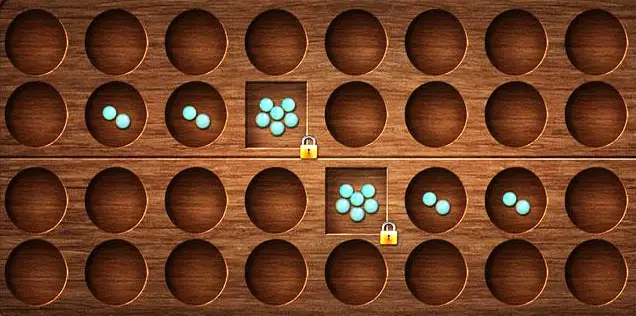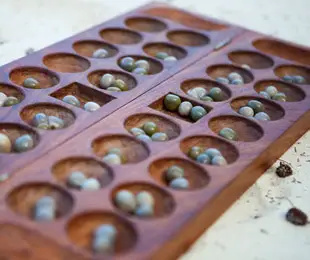Bao means 'wood' in Swahili language and this mancala variant is very popular in Africa. It's played on a board with four rows of eight bowls. The bowls must be big enough so 12-15 stones can fit in them. The top row contains the seeds of one player and the bottom two rows contain the seeds of the other. There are two holes, called the nyumba, that are square.
The aim of the game is to be the first player to empty the front row of your opponent or deprive him of all legal moves.
Both players start with 32 stones and at the start ten stones are placed like this:

I. The Namua Stage
During the first stage, called the Namua stage, each turn each player brings one seed into play. Therefor, players put a stone from their stock in bowl on their front row that already contains one or more seeds and whose opposing hole also contains one or more seeds. Now, they can capture the stones in the opposing bowl. A player must always capture if he cans.
The captured stones are brought back into play by putting them in "kichwa". This is the extreme left or right bowl of the front row.
When a bowl with more than one stone is captured, then all those stones must be sow on the front row and one stone in each bowl, beginning in the left or right kichwa. A player can't skip bowls when sowing the captured stones. But there is an exception: when you capture stones on a kichwa, you must put them back them on the same side where you captured them.
Capturing with Captured Seeds
Captured stones immediately change sides and can capture even more opposing stones. When the last sowned stone comes in a bowl already containing stones, you can capture the stones in the opposing bowl. When the opposing bowl is empty, you can take the stones from the last bowl and start to sow them again in the same direction.
You must always keep on sowing or capturing until your last seed falls in an empty bowl.
Takasa
A takasa is a move when you can't start by capturing stones. In that case, you just put a stone in one of your last bowls with one or more stones, take all stones and start sowing them until the last seed comes in an empty bowl.
During a takasa, no captures are allowed because you didn't start with a capture.
Nyumba
The bowl marked with a rectangle is always the 5th one from the left on your front row and special rules occur to this bowl. The nyumba ceases to be a nyumba as soon as the stones it contains are sown and then it becomes just an ordinary bowl.
Sowing the seeds from your nyumba is very tricky to do and it's one of the key moments of the game.
When the last seeded stone falles in the nyumba and the opposing bowl is empty, the player may end his turn if he wishes. He don't need to capture the stones in the nyumba and sow them.
If the nyumba is the only bowl left and are having a takasa, then you can place a stone in your nyumba then take out two stones and sow them to the left or to the right.
II. The Mtaji Stage

This stage starts when all your stones of your stock are brought into play. In this stage, you must always capture when you can. So, you take a bowl on your front or back row that, after sowing the containing stones, ends with the last stone falling in a bowl having stones in the opposing bowl.
Playing bowls with only one stone is forbidden.
When no captures are possible (takasa), the player must take a bowl from the front row and sow it to the left or right but during this move, captures are not allowed like in the Namua stage.
When there are no occupied bowls in the front row, the player can sow a bowl from the back row.
If there is a bowl that is the only opposing bowl for your opponent, than this bowl may not be sown during a takasa.
Note: you can never start sowing a bowl with only one stone.
Continue Reading


